TY001 Module Datasheet
Last Updated on : 2025-05-29 06:21:51download
Product overview
TY001 is a low-power embedded Wi-Fi module that Tuya has developed. It consists of a highly integrated RF chip (RTL8188FTV) and a few peripherals. Besides, it is built in with a Wi-Fi network protocol stack and rich library functions. TY001 has a 1T1R WALN whose rate can be up to 72.2 Mbps. TY001 is an RTOS platform that integrates all function libraries of the Wi-Fi MAC and TCP/IP. You can develop embedded Wi-Fi products as required.
The functional block diagram of RTL8188FTV is shown below:
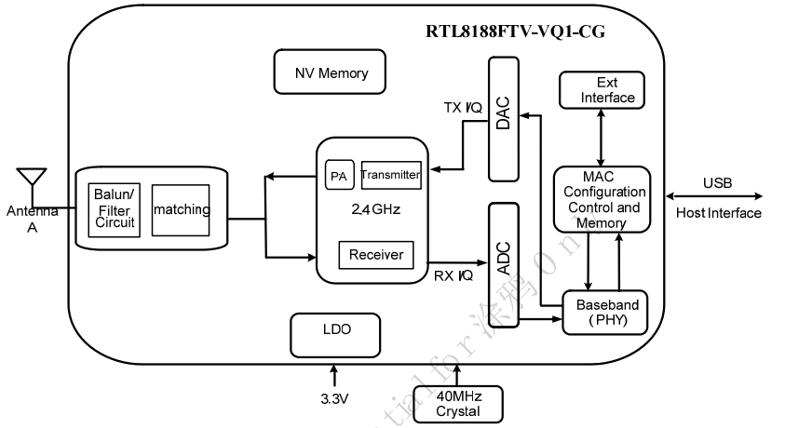
Features
- Working voltage: 3.0 to 3.6 V
- Host Interface: USB 2.0
- Wi-Fi/Bluetooth connectivity
- 802.11 b/g/n20
- Channels 1 to 14@2.4 GHz (CH1 to 11 for US/CA and CH1 to 13 for EU/CN)
- Support WEP, WPA, WPA2, and WPA2 PSK (AES) security modes
- 19-dBm output power in 802.11b mode
- Working temperature: 0℃ to 70℃
Applications
- Intelligent building
- Smart household and home appliances
- Smart socket and light
- Industrial wireless control
- Baby monitor
- Network camera
- Intelligent bus
Module interfaces
Dimensions and package
TY001 has 2 rows of pins, 6 in total.
The dimensions of TY001 are 12.3±0.35 mm (W)×13±0.35 mm (L) ×1.8±0.15 mm (H). The dimensions of TY001 are as follows:
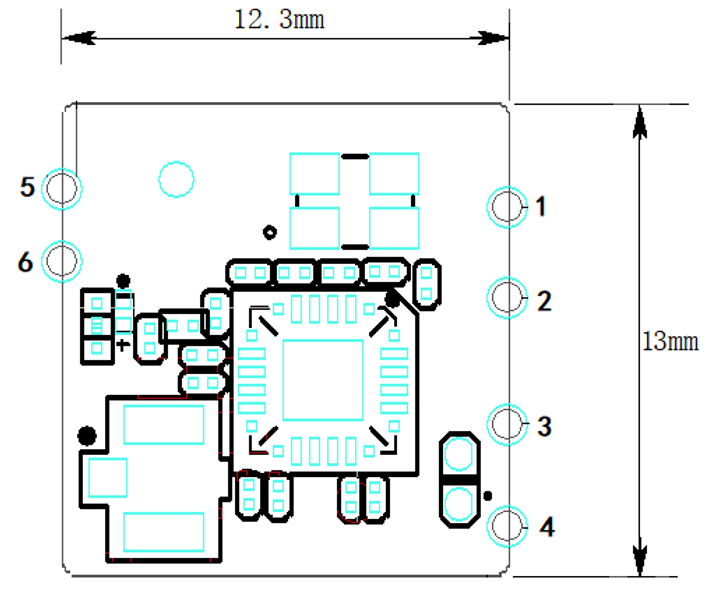
Pin definition
The definition of interface pins is shown in the following table:
| Pin number | Symbol | I/O type | Function |
|---|---|---|---|
| 1 | GND | P | Power supply reference ground |
| 2 | UDP | I/O | USB differential pair for sending and receiving signals |
| 3 | UDM | I/O | USB differential pair for sending and receiving signals |
| 4 | 3.3V | P | Power supply pin (3.3V) |
| 5 | GND | P | Power supply reference ground |
| 6 | RF | / | RF output interface |
Note:
Pindicates a power supply pin and I/O indicates an input/output pin.
Electrical parameters
Absolute electrical parameters
| Parameter | Description | Minimum value | Maximum value | Unit |
|---|---|---|---|---|
| Ts | Storage temperature | -20 | 105 | ℃ |
| VDD | Power supply voltage | -0.3 | 3.6 | V |
| Static electricity discharge voltage (human body model) | TAMB-25℃ | - | 2 | KV |
| Static electricity discharge voltage (machine model) | TAMB-25℃ | - | 0.5 | KV |
Working conditions
| Parameter | Description | Minimum value | Typical value | Maximum value | Unit |
|---|---|---|---|---|---|
| Ta | Working temperature | 0 | - | 70 | ℃ |
| VCC | Working voltage | 3.0 | 3.3 | 3.6 | V |
| VIL | I/O low-level input | - | 0 | 0.9 | V |
| VIH | I/O high-level input | 2.0 | 3.3 | 3.6 | |
| VOL | I/O low-level output | 0 | - | 0.33 | |
| VOH | I/O high-level output | 2.97 | - | 3.3 | V |
| Imax | I/O drive current | - | - | 12 | mA |
RF power consumption
-
TX power consumption
Symbol Mode Power Peak value (Typical value) Unit IRF 11b 11Mbps 17dBm 306 mA IRF 11g 54Mbps 15dBm 285 mA IRF 11n BW20 MCS0 14dBm 235 mA IRF 11n BW20 MCS7 13dBm 210 mA -
RX power consumption
Symbol Mode Average value Peak value (Typical value) Unit IRF 11B 11M 63 65 mA IRF 11G 54M 65 67 mA IRF 11N HT20 MCS7 65 67 mA
RF parameters
Basic RF features
| Parameter | Description |
|---|---|
| Frequency range | 2.412 to 2.484 GHz |
| Wi-Fi standard | IEEE 802.11b/g/n (channels 1 to 14) |
| Data transmission rate | 11b: 1, 2, 5.5, and 11 (Mbps) |
| Data transmission rate | 11g: 6, 9, 12, 18, 24, 36, 48, and 54 (Mbps) |
| Data transmission rate | 11n: HT20 MCS0 to 7 |
| Antenna type | External antenna. If an IPEX interface is reserved, TY001 can be connected to the IPEX antenna. |
TX performance
| Parameter | Minimum value | Typical value | Maximum value | Unit |
|---|---|---|---|---|
| Average RF output power, 802.11b CCK Mode 1M | 17 | 18.5 | 20 | dBm |
| Average RF output power, 802.11g OFDM Mode 54M | 14 | 15.5 | 17 | dBm |
| Average RF output power, 802.11n OFDM Mode MCS7 | 13 | 14.5 | 16 | dBm |
| Frequency error | -20 | - | 20 | ppm |
| EVM@802.11b CCK 11 Mbps Mode 17.5 dBm | - | - | -10 | dB |
| EVM@802.11g OFDM 54 Mbps Mode 14.5 dBm | - | - | -29 | dB |
| EVM@802.11n OFDM MCS7 Mode 13.5 dBm | - | - | -30 | dB |
RX Performance
| Parameter | Minimum value | Typical value | Maximum value | Unit |
|---|---|---|---|---|
| PER<8%, RX sensitivity, 802.11b CCK Mode 1M | -92 | -94 | -96 | dBm |
| PER<10%, RX sensitivity, 802.11g OFDM Mode 54M | -74 | -76 | -78 | dBm |
| PER<10%, RX sensitivity, 802.11n OFDM Mode MCS7 | -71 | -73 | -75 | dBm |
Antenna information
Antenna type
TY001 uses an external antenna. TY001 can be connected to the external antenna through its upper half hole, or it can be connected to the IPEX antenna via the IPEX interface.
Antenna interference reduction
To ensure optimal Wi-Fi performance, it is recommended that the antenna be at least 15 mm away from other metal parts.
Specifications of antenna connector
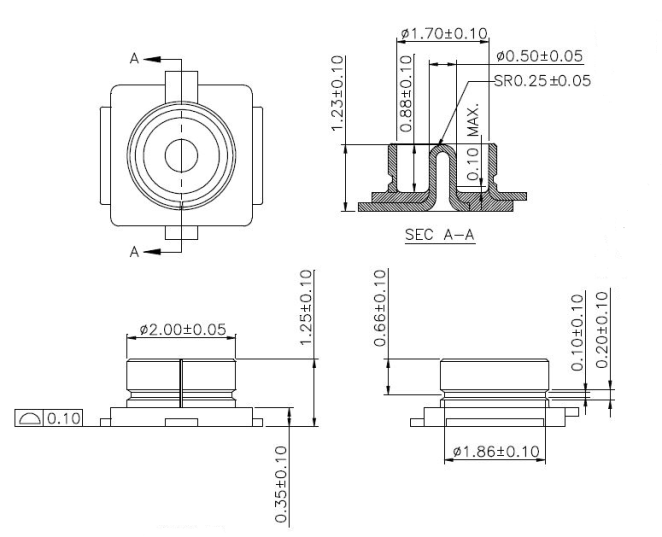
Packaging information and production instructions
Mechanical dimensions
The mechanical dimensions of the PCB of TY001 are 12.3±0.35 mm (W)×13±0.35 mm (L) ×0.8±0.1 mm (H). The following figure shows the mechanical dimensions of TY001:
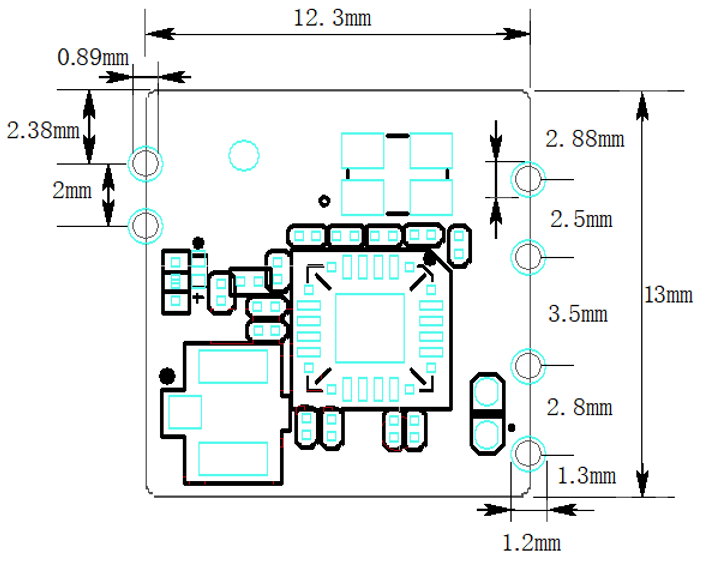
Note: The default dimensional tolerance is ±0.35 mm. If you have specific requirements on dimensions, make them clear in the module datasheet after communication.
Production instructions
-
The Tuya SMT module should be mounted by the SMT device. After being unpacked, it should be soldered within 24 hours. Otherwise, it should be put into the drying cupboard where the RH is not greater than 10%; or it needs to be packaged under vacuum again and the exposure time needs to be recorded (the total exposure time cannot exceed 168 hours).
- SMT devices:
- Mounter
- SPI
- Reflow soldering machine
- Thermal profiler
- Automated optical inspection (AOI) equipment
- Baking devices:
- Cabinet oven
- Anti-electrostatic and heat-resistant trays
- Anti-electrostatic and heat-resistant gloves
- SMT devices:
-
Storage conditions for a delivered module:
-
The moisture-proof bag must be placed in an environment where the temperature is below 40°C and the relative humidity is lower than 90%.
-
The shelf life of a dry-packaged product is 12 months from the date when the product is packaged and sealed.
-
There is a humidity indicator card (HIC) in the packaging bag.
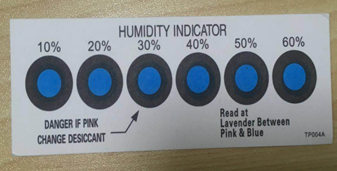
-
-
The module needs to be baked in the following cases:
- The packaging bag is damaged before unpacking.
- There is no HIC in the packaging bag.
- After unpacking, circles of 10% and above on the HIC become pink.
- The total exposure time has lasted for over 168 hours since unpacking.
- More than 12 months have passed since the sealing of the bag.
-
Baking settings:
- Temperature: 40°C and ≤ 5% RH for reel package and 125°C and ≤5% RH for tray package (please use the heat-resistant tray rather than a plastic container).
- Time: 168 hours for reel package and 12 hours for tray package.
- Alarm temperature: 50°C for reel package and 135°C for tray package.
- Production-ready temperature after natural cooling: < 36°C.
- Re-baking situation: If a module remains unused for over 168 hours after being baked, it needs to be baked again.
- If a batch of modules is not baked within 168 hours, do not use the wave soldering to solder them. Because these modules are Level-3 moisture-sensitive devices, they are very likely to get damp when exposed beyond the allowable time. In this case, if they are soldered at high temperatures, it may result in device failure or poor soldering.
-
In the whole production process, take electrostatic discharge (ESD) protective measures.
-
To guarantee the passing rate, it is recommended that you use the SPI and AOI to monitor the quality of solder paste printing and mounting.
Recommended oven temperature curve
Set oven temperatures according to the following temperature curve of reflow soldering. The peak temperature is 245°C.

-
A: Temperature axis
-
B: Time axis
-
C: Liquidus temperature: 217 to 220°C
-
D: Ramp-up slope: 1 to 3°C/s
-
E: Duration of constant temperature: 60 to 120s; the range of constant temperature: 150 to 200°C
-
F: Duration above the liquidus: 50 to 70s
-
G: Peak temperature: 235 to 245°C
-
H: Ramp-down slope: 1 to 4°C/s
Note: The above curve is just an example of the solder paste SAC305. For more details about other solder pastes, please refer to Recommended oven temperature curve in the solder paste specifications.
Storage conditions
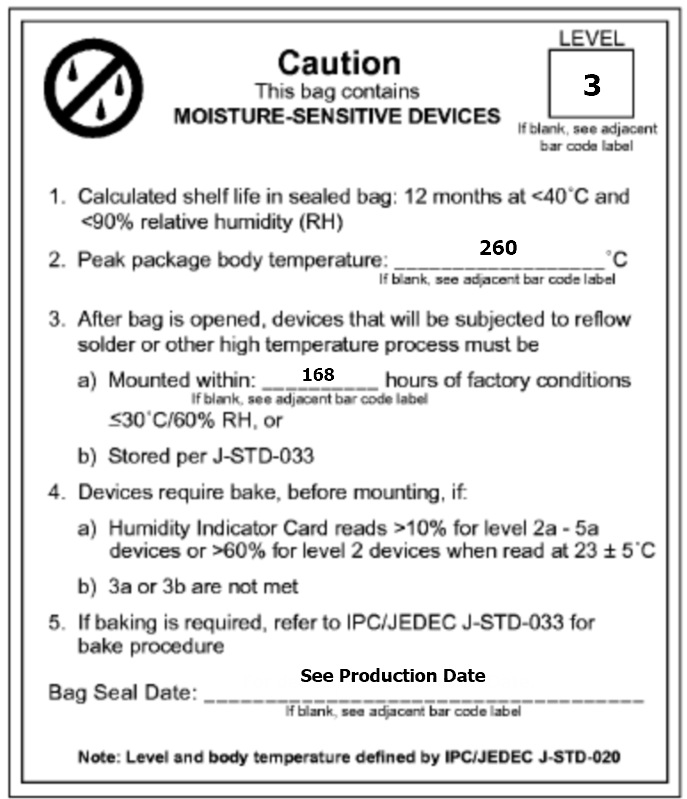
MOQ and packaging information
| Product number | MOQ (pcs) | Shipping packaging method | The number of modules per reel | The number of reels per carton |
|---|---|---|---|---|
| TY001 | 6800 | Tape reel | 1700 | 4 |
Is this page helpful?
YesFeedbackIs this page helpful?
YesFeedback





